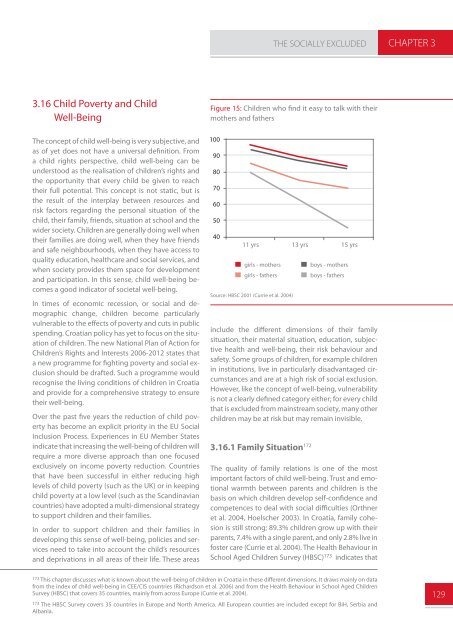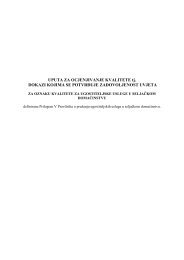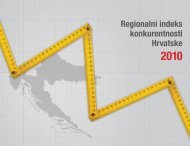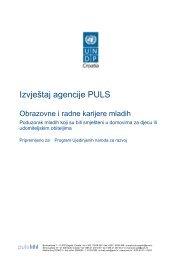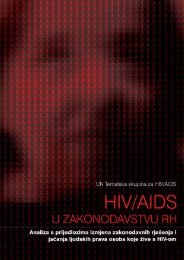WEB engleska verzija end.indd - UNDP Croatia
WEB engleska verzija end.indd - UNDP Croatia
WEB engleska verzija end.indd - UNDP Croatia
- No tags were found...
Create successful ePaper yourself
Turn your PDF publications into a flip-book with our unique Google optimized e-Paper software.
THE SOCIALLY EXCLUDEDCHAPTER 33.16 Child Poverty and ChildWell-BeingThe concept of child well-being is very subjective, andas of yet does not have a universal definition. Froma child rights perspective, child well-being can beunderstood as the realisation of children’s rights andthe opportunity that every child be given to reachtheir full potential. This concept is not static, but isthe result of the interplay between resources andrisk factors regarding the personal situation of thechild, their family, fri<strong>end</strong>s, situation at school and thewider society. Children are generally doing well whentheir families are doing well, when they have fri<strong>end</strong>sand safe neighbourhoods, when they have access toquality education, healthcare and social services, andwhen society provides them space for developmentand participation. In this sense, child well-being becomesa good indicator of societal well-being.In times of economic recession, or social and demographicchange, children become particularlyvulnerable to the effects of poverty and cuts in publicsp<strong>end</strong>ing. <strong>Croatia</strong>n policy has yet to focus on the situationof children. The new National Plan of Action forChildren’s Rights and Interests 2006-2012 states thata new programme for fighting poverty and social exclusionshould be drafted. Such a programme wouldrecognise the living conditions of children in <strong>Croatia</strong>and provide for a comprehensive strategy to ensuretheir well-being.Over the past five years the reduction of child povertyhas become an explicit priority in the EU SocialInclusion Process. Experiences in EU Member Statesindicate that increasing the well-being of children willrequire a more diverse approach than one focusedexclusively on income poverty reduction. Countriesthat have been successful in either reducing highlevels of child poverty (such as the UK) or in keepingchild poverty at a low level (such as the Scandinaviancountries) have adopted a multi-dimensional strategyto support children and their families.In order to support children and their families indeveloping this sense of well-being, policies and servicesneed to take into account the child’s resourcesand deprivations in all areas of their life. These areasFigure 15: Children who find it easy to talk with theirmothers and fathers10090807060504011 yrs 13 yrs 15 yrsgirls - mothersgirls - fathersSource: HBSC 2001 (Currie et al. 2004)include the different dimensions of their familysituation, their material situation, education, subjectivehealth and well-being, their risk behaviour andsafety. Some groups of children, for example childrenin institutions, live in particularly disadvantaged circumstancesand are at a high risk of social exclusion.However, like the concept of well-being, vulnerabilityis not a clearly defined category either; for every childthat is excluded from mainstream society, many otherchildren may be at risk but may remain invisible.3.16.1 Family Situation 172boys - mothersboys - fathersThe quality of family relations is one of the mostimportant factors of child well-being. Trust and emotionalwarmth between parents and children is thebasis on which children develop self-confidence andcompetences to deal with social difficulties (Orthneret al. 2004, Hoelscher 2003). In <strong>Croatia</strong>, family cohesionis still strong; 89.3% children grow up with theirparents, 7.4% with a single parent, and only 2.8% live infoster care (Currie et al. 2004). The Health Behaviour inSchool Aged Children Survey (HBSC) 173 indicates that172 This chapter discusses what is known about the well-being of children in <strong>Croatia</strong> in these different dimensions. It draws mainly on datafrom the index of child well-being in CEE/CIS countries (Richardson et al. 2006) and from the Health Behaviour in School Aged ChildrenSurvey (HBSC) that covers 35 countries, mainly from across Europe (Currie et al. 2004).173 The HBSC Survey covers 35 countries in Europe and North America. All European counties are included except for BiH, Serbia andAlbania.129


